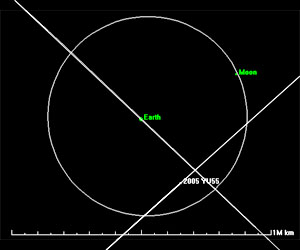A Close Shave In The Vastness Of Outer Space
- May 25th, 2011 12:01 pm PT
Darin Krogh
Do you like this article?
If you are tired of thinking about global warming, terrorist attacks or contracting a new deadly virus, maybe you could get out of your rut by mulling over the possibility that some large celestial body may be on a collision course with our own planet.
In the coming November, an asteroid named YU55 will be passing by Earth at a distance of just 201,000 miles, the asteroid will be the largest object ever to approach the earth so close. Astronomers are calling it “a close shave in the vastness of outer space”. The rock will pass between the Earth and the Moon. Even Bruce Willis couldn’t save us.
If a collision happens, the memory of the 4th of July Fireworks would be dimmed. Pig-Out-In-The-Park would have to be cancelled for a couple thousand years. YU55, would have an impact equivalent to 65,000 atom bombs and would leave a crater more than six miles wide and 2,000 feet deep.
Scientists say that the fatal cosmic concussion will probably come from a giant chunk of rock like YU55 – one of the many that jump from the asteroid belt under the evil influence of Jupiter – or a comet returning to our solar system. That comet would show up as a stationary but growing dot of light in the night sky. It would appear stationary because it would be coming straight at us.
Although total planetary destruction is total planetary destruction, a comet hit, rather than a meteor strike, might be the preferable finish to life as we know it.
The first advantage of a comet impact is that astronomers would be able to give us more time to prepare for extinction. You would not have time to read a thick novel, go on a diet, work a 12-step program or even play an extended game of Monopoly but you would have time for a frank hold-no-punches talk with your in-laws or to unload some bottled-up grievances to your boss.
A comet would also provide several days of spectacular visual effect with its fluffy ice and vapors streaming behind. On the other hand, a typical giant meteor would provide nothing visually remarkable until it flamed up for a few scant seconds prior to the explosion that would wipe us all out.
Another reason that we Earthlings might prefer oblivion by comet is that the meteor strike has been done before.
Scientists say that dust from a meteor-hit filled the air back in 65 million B.C. Most life on Earth was wiped out.
Scientists know this because buried in the Earth at the 65 million year depth is a layer of iridium, a non-biodegradable element that is relatively rare on Earth but a common component of meteors. Dinosaur fossils are found below that iridium layer while mammal bones are found above. If we take another big hit, our only comfort is that a life form higher than humans may evolve above our own bones.
You have probably seen the recent movies and television shows that involve blowing up one of these errant comets or meteors before they strike our Earth. Scary. Scientists are working on real scenarios. We should all send money to any scientists working on this kind of “star wars”.
Most of these scientists think that the job of blowing up these Earth wreckers is extremely complicated. We are probably not much better off than the dinosaurs. We’ll be gone but not always forgotten; after a few million years our successors (the new life forms) will dig up our bones and display them standing naked in their museums with a sign that says, “They didn’t know what hit them.”
There will probably be scary movies made about us and they are sure to make disparaging remarks about our tiny brains.
NOTE: If you want to be “in-the-know” before the Earth is obliterated, go to the Spokane Astronomical Society’s web site ( spokaneastronomical.org ). That knowledgeable group of amateurs and professionals has lots of free information and they hold “Star Parties” where they provide powerful telescopes, free to the public, so that you might get a look at the celestial threats that are currently headed our way. Don’t tell me about it.
Continue reading on Examiner.com A Close Shave In The Vastness Of Outer Space - Spokane Family | Examiner.com http://www.examiner.com/family-in-sp...#ixzz1NT8ZyNrM




 Reply With Quote
Reply With Quote

 Asteroid 2005 YU55 to Approach Earth on November 8, 2011
Asteroid 2005 YU55 to Approach Earth on November 8, 2011 


 Radar image of asteroid 2005 YU55. Image credit: NASA/Cornell/Arecibo
Radar image of asteroid 2005 YU55. Image credit: NASA/Cornell/Arecibo 

 There are countless predictions that the end of the world comes to December 21, 2012. Most massive of which is that of their Mayan calendar. Interestingly, however, and time in which the approaching asteroid 2005 YU55. It is expected to hand our planet a little more than a year.
There are countless predictions that the end of the world comes to December 21, 2012. Most massive of which is that of their Mayan calendar. Interestingly, however, and time in which the approaching asteroid 2005 YU55. It is expected to hand our planet a little more than a year. 

Bookmarks